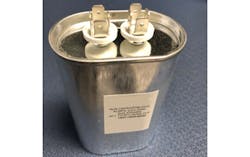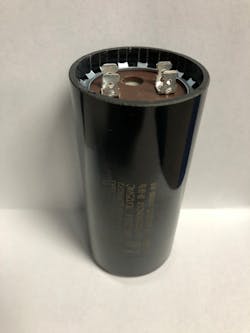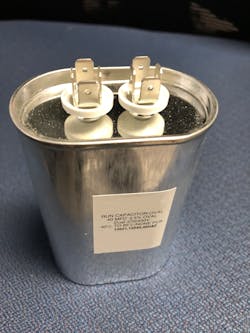Single-phase motors, adjustable-speed drives (ASDs), and power factor (PF) correction applications often depend on capacitors to operate properly. This article explains how to test these critical components for electric motors in general, as well as for specific use applications like motor starting and PF correction (see Photo 1 and Photo 2).
Note: Follow all applicable safety rules and procedures when testing or inspecting an electric motor or doing any other electrical work.
Preparation for testing
For capacitors rated 600V or less, discharge any residual capacitance by connecting a 15 to 20 kilohms resistor rated 5W or greater across the two capacitor terminals for at least 10 sec. Verify that the voltage has decayed to zero by connecting a DC voltmeter to the capacitor terminals. If there is a residual charge, then the voltage will gradually decay as the meter discharges the capacitor. For capacitors rated above 600V, check with the capacitor manufacturer for the proper test procedure. Before proceeding to test a capacitor, disconnect any leads connected to its terminals.
Note: If there are multiple capacitors, disconnect and test one at a time, and then reconnect the tested capacitor before disconnecting and testing another one.
Resistance meter testing
Capacitive charge test. A simple pass/fail test for a capacitor determines if it can develop a capacitive charge. Using an analog multimeter (preferred) set to the kilohms scale, connect the meter leads to the two capacitor terminals while observing the resistance reading. If the capacitor is functional, the voltage applied by the meter’s internal battery will initially produce a relatively high current that drops off rapidly as the capacitor charges. The resistance reading should behave inversely with the change in current, increasing rapidly until it exceeds the meter’s scale — essentially “infinity.”
A digital multimeter (DMM) set to the ohms scale can also be used to check for capacitive charge. Compared with an analog meter, however, it may be more difficult to detect the rapid increase in measured resistance with a DMM.
Passing the capacitive charge test indicates that a capacitor is functional. However, this test does not verify that it has its rated capacitance.
Shorted capacitor test. To detect a shorted capacitor, set an analog or a digital multimeter to the ohms scale and connect it to the two terminals of the capacitor. An essentially “zero” ohm reading indicates a shorted capacitor. In addition, inspect the capacitor for obvious defects such as oil leakage, cracks, or a bulging case.
For larger, fuse-protected power capacitors, check the fuse. An open fuse indicates the capacitor is shorted.
Capacitance meter testing
Capacitance is typically expressed in microfarads (MFDs or µFs). These values are important for motor start and run capacitors because they affect the starting torque of single-phase capacitor motors, as well as the running current of motors that have run capacitors. To determine a capacitor’s microfarad value, connect a capacitance tester to its two terminals.
In general, the microfarad value should be within about 20% of its rated value (which may be a range). An open-circuited capacitor typically charges up quickly and has an extremely high microfarad (usually off-scale) value. Conversely, a short-circuited capacitor will have a very low, or “zero,” microfarad value. If the microfarad reading is unsteady (going up and down), the capacitor is probably arcing internally and should be replaced.
A capacitor that hasn’t been used for a long time may need to be “re-formed” to restore its capacitive charge. What constitutes “a long time” has no set values, but a capacitor that has been out of service for a year or more probably needs re-forming. Check the equipment/capacitor manufacturer’s manual for information about inactive periods and re-forming procedures.
Capacitance of circuit test. For applications with multiple capacitors with known capacitance ratings (e.g., the start winding of an integral hp/kW single-phase motor), measure the capacitance of the complete circuit and compare it with the rated capacitance. This test verifies that the interconnection of the multiple capacitors is correct.
The microfarad value of capacitors varies inversely as compared to the resistance values of resistors in series or in parallel. That is, the microfarad value of capacitors in parallel is the sum of the individual capacitor microfarad values (total capacitance = C1 + C2 ...+ Cn). The microfarad value of capacitors in series is determined mathematically using the same method as for resistors in parallel (total capacitance = 1 ÷ [(1 ÷ C1) + (1 ÷ C2) ... + (1 ÷ Cn)].
For example, two capacitors rated 400 microfarads connected in parallel result in 800 microfarads (400 + 400). The same two capacitors in series result in 200 microfarads [1 ÷ [(1 ÷ 400) + (1 ÷ 400)]].
Failures
Most premature capacitor failures are due to short circuits. Those that occur later in a capacitor’s lifetime typically are open circuits that are prevalent with electrolytic (e.g., motor start) capacitors where the electrolyte has dried up.
Factors affecting capacitor life include applied voltage, which can exceed equipment line voltage, and operating and ambient temperatures. The life expectancy of power capacitors in such applications as ASDs and PF correction varies as an inverse exponential with overvoltage.
For example, a 10% overvoltage reduces capacitor life by about half. Similar to motor windings, power capacitor life is halved for every 10°C increase in case temperature. The converse of these two rules also applies. Capacitor life increases exponentially with reduced voltage and with reduced temperature.
Overheating a motor start capacitor by energizing it for more than a few seconds can thermally damage or destroy it. A repetitive overvoltage condition can reduce its capacitance (microfarads). An open pressure vent also indicates internal overpressure that usually is associated with deterioration over time. Both continuous overvoltage and transient overvoltage can damage a run capacitor.
Bishop is a senior technical support specialist with the Electrical Apparatus Service Association (EASA) in St. Louis. Contact him at [email protected].


